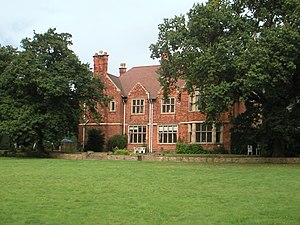
Bretby Hall is a country house at Bretby, Derbyshire, England, north of Swadlincote and east of Burton upon Trent on the border with Staffordshire. It is a Grade II listed building. The name Bretby means "dwelling place of Britons".

Compton Verney is a parish and historic manor in the county of Warwickshire, England. The population taken at the 2011 census was 119. The surviving manor house is the Georgian mansion Compton Verney House.
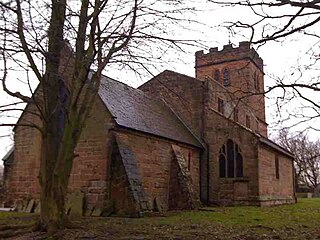
Wishaw is a village and civil parish in the north-west of Warwickshire, England. The population of the civil parish at the 2011 census was 125. It is located within the district of North Warwickshire and is the home of The Belfry golf resort, which has hosted the Ryder Cup on four occasions. The village is also home to some notable buildings. The site of The Belfry was once the location of Moxhull Park, a stately home that belonged to the Ryland family until it burnt down in the early twentieth century. The manor house was rebuilt one mile away to its present location on Holly Lane as Moxhull Hall. Wishaw is also the location of a church dedicated to the local Saint Chad. The church is popular with marriages and regular Sunday services, despite a very small local population.

Offchurch Bury is a manor house one mile north-west of the centre of the village of Offchurch, Warwickshire, England. It is supposed to represent the site of a palace of the Anglo-Saxon King Offa of Mercia (d.796), after which Offchurch is named, "bury" being a corruption of "burh" meaning a fortified place. William Dugdale in his Antiquities of Warwickshire (1656) stated concerning the manor of Offchurch:
Langley Hall was a manor house just off Fox Hollies Road, one mile from the centre of Walmley in Sutton Coldfield in the historic county of Warwickshire.
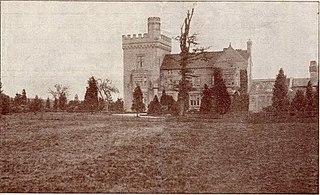
Ladbrooke is an historic estate in the parish of Tanworth-in-Arden, Warwickshire, England. The early history until the late 14th century is sparse and inextricably confused with the manor and parish of Ladbroke near Southam in Warwickshire, 34 km to the south-east. The confusion arises not only because both places within the same county are spelled variously and identically in historic documents, but mainly because the mediaeval de Lodbroke family appear to have held estates in each place. The 1619 Heraldic Visitation of Warwickshire which gives the pedigree of the "de Lodbroke" family, states them as "Dominus de Lodbrooke" and makes no mention of Tanworth-in-Arden. The Victoria County History is however clear that the seat of the de Lodbroke family was Ladbroke near Southam and not Ladbrooke in the parish of Tanworth-in-Arden.

Umberslade Hall is a 17th-century mansion converted into residential apartments situated in Nuthurst near Tanworth-in-Arden, Warwickshire. It is a Grade II* listed building.

Wroxall Abbey is a substantial Victorian mansion house situated at Wroxall, Warwickshire which was converted for use as a hotel, spa, wedding venue and conference centre. It is a Grade II listed building.
Hermitage Manor is a small manor house in Warwickshire (UK) with a trihedral moat, associated land and farm. A manor house or fortified manor-house is a country house, which has historically formed the centre of a manor. The term is sometimes applied to relatively small country houses which belonged to gentry families, as well as to grand stately homes, particularly as a technical term for minor late medieval castles more intended for show than for defence.

Astley Castle is a ruinous moated fortified 16th century manor house in North Warwickshire. It has been listed as a Grade II* listed building since 1952 and as a Scheduled Ancient Monument since 1994. It was derelict and neglected since it was severely damaged by fire in 1978 whilst in use as a hotel and was officially a Building at Risk. The building reopened as a holiday let in 2012 after extensive and novel renovations that combine modern elements within the (mostly) renaissance remains. In 2013, Astley Castle won the Royal Institute of British Architects Stirling Prize for architecture, as an "exceptional example" of the blending of an ancient monument with modern architecture.

Welcombe Hotel occupies a 19th-century former country mansion house near Stratford upon Avon, Warwickshire, which was previously known as Welcombe House. It is a Grade II* listed building.

Walton Hall is a 16th-century country mansion at Walton, near Wellesbourne, Warwickshire, once owned by Lord Field and the entertainer Danny La Rue, now in use as a hotel which is now part of Accor Hotels. It is a Grade II* listed building.
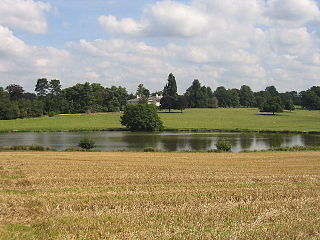
Berkswell Hall is a 19th-century country house at Berkswell, formerly Warwickshire now West Midlands, now converted into residential apartments. It is a Grade II* listed building.
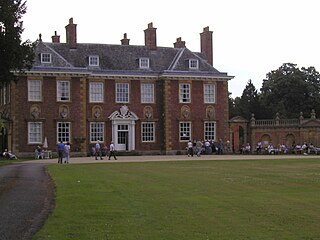
Honington Hall is a privately owned 17th century country house at Honington, near Stratford on Avon, Warwickshire. It has Grade I listed building status.

Brownsover Hall is a 19th-century mansion house in the old village of Brownsover, Rugby, Warwickshire which has been converted for use as a hotel. It is a Grade II* listed building.

Clopton House is a 17th-century country mansion near Stratford upon Avon, Warwickshire, now converted into residential apartments. It is a Grade II* listed building.

Caludon Castle is a Scheduled Ancient Monument and Grade I listed building in Coventry, in the West Midlands of England. A second moated site 190 metres (620 ft) to the south is a Scheduled Ancient Monument in its own right. The castle is now a ruin, and all that remains is a large fragment of sandstone wall. What remains of the estate is now an urban park, owned and run by Coventry City Council, but much of it was sold and developed into housing estates in the early 20th century.
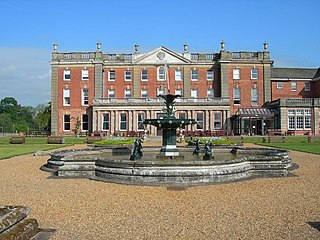
Newbold Revel refers to an existing 18th-century country house and a historic manorial estate in North East Warwickshire. In the fifteenth century, the estate was the home of the medieval author Sir Thomas Malory. The house is today used by HM Prison Service as a training college; it is a Grade II* listed building.

Madeley Court is a 16th-century country house in Madeley, Shropshire, England which was originally built as a grange to the medieval Wenlock Priory. It has since been restored as a hotel.

Buckenham Tofts is a now deserted historic parish and manor in Norfolk, England, situated about 7 miles north of Thetford, and since 1942 situated within the Stanford Training Area, a 30,000-acre military training ground closed to the public. It was situated about one mile south of the small village of Langford, with its Church of St Andrew, and about one mile west of Stanford, with its All Saints' Church and one mile north of West Tofts, with its Church of St Mary, all deserted and demolished villages. None of these settlements are shown on modern maps but are simply replaced by "Danger Area" in red capital letters.
